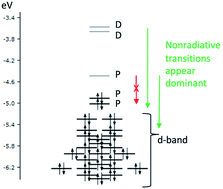Characterization of Pt-doping effects on nanoparticle emission: a theoretical look at Au24Pt(SH)18 and Au24Pt(SC3H7)18†
Abstract
Developments in nanotechnology have made the creation of functionalized materials with atomic precision possible. Thiolate-protected gold nanoclusters, in particular, have become the focus of study in literature as they possess high stability and have tunable structure–property relationships. In addition to adjustments in properties due to differences in size and shape, heteroatom doping has become an exciting way to tune the properties of these systems by mixing different atomic d characters from transition metal atoms. Au24Pt(SR)18 clusters, notably, have shown incredible catalytic properties, but fall short in the field of photochemistry. The influence of the Pt dopant on the photoluminescence mechanism and excited state dynamics has been investigated by a few experimental groups, but the origin of the differences that arise due to doping has not been clarified thoroughly. In this paper, density functional theory methods are used to analyze the geometry, optical and photoluminescent properties of Au24Pt(SR)18 in comparison with those of [Au25(SR)18]1−. Furthermore, as these clusters have shown slightly different geometric and optical properties for different ligands, the analysis is completed with both hydrogen and propyl ligands in order to ascertain the role of the passivating ligands.

- This article is part of the themed collection: Nanoalloys: recent developments and future perspectives


 Please wait while we load your content...
Please wait while we load your content...